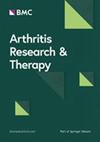血清学新表位片段生物标志物反映的系统性硬化症患者VII型胶原转换加速
IF 4.9
2区 医学
Q1 Medicine
引用次数: 0
摘要
系统性硬化症(SSc)是一种罕见的自身免疫性疾病,以微血管病变、自身抗体产生、皮肤和内脏纤维化为特征。SSc中胶原蛋白转换被破坏导致胶原蛋白过度积累,但皮肤基底膜的关键成分VII型胶原蛋白的重塑尚不清楚。本研究通过测量血清中形成(PRO-C7)和降解(C7M)生物标志物的水平,以及它们与其他ECM生物标志物和临床表现的相关性,研究了SSc中VII型胶原的转化。开发了一种自动免疫分析法PRO-C7,用于定量VII型胶原的形成。此外,在一项针对SSc患者的事后研究中,对C7M以及III型、IV型和VI型胶原转化生物标志物进行了分析。使用Shapiro-Wilk检验评估所有感兴趣变量的正态性。采用Spearman相关检验和Welch t检验来评估SSc患者与健康对照组之间生物标志物水平的关联和差异。采用线性回归模型评估生物标志物水平与改良罗德曼皮肤评分(mRSS)之间的关系。为了控制多重比较中的I类误差,采用Bonferroni校正来调整显著性水平。结果显示,SSc患者和对照组中VII型和VI型胶原转化生物标志物水平显著升高。PRO-C3、PRO-C6水平与mRSS评分显著相关(R2 = 0.156, p = 0.0004;R2 = 0.222, p < 0.0001),而PRO-C7和C7M则没有。PRO-C7和C7M分别与c反应蛋白和红细胞沉降率存在中度但显著的相关性(ρ = 0.39, p = 0.0006;PRO-C7的ρ = 0.24 p = 0.045;ρ = 0.31, p = 0.0076;对于C7M, ρ = 0.28, p = 0.014)。C7M与III型、IV型、VI型胶原形成及降解生物标志物显著相关,而PRO-C7仅与PRO-C6、C6M显著相关。此外,伴有肾功能不全的SSc患者C7M水平较高,PRO-C7水平升高与抗dsdna相关,而PRO-C7水平降低与SSc的毛细血管异常有关。总之,反映VII型胶原转换的PRO-C7和C7M有望成为SSc的新的血清学生物标志物。本文章由计算机程序翻译,如有差异,请以英文原文为准。
Accelerated Type VII collagen turnover in systemic sclerosis patients, reflected by serological neo-epitope fragment biomarkers
Systemic sclerosis (SSc) is a rare autoimmune disease characterized by microvasculopathy, autoantibody production, and fibrosis of the skin and internal organs. Disrupted collagen turnover in SSc leads to excessive collagen accumulation, but the remodeling of type VII collagen, a key component of the skin’s basement membrane, is not well understood. This study investigates type VII collagen turnover in SSc by measuring serum levels of its formation (PRO-C7) and degradation (C7M) biomarkers and characterizing their association with other ECM biomarkers and clinical manifestations. An automated immunoassay, PRO-C7, was developed to quantify type VII collagen formation. Additionally, C7M, along with type III, IV, and VI collagen turnover biomarkers, were analyzed in a post-hoc study of SSc patients. The normality of all variables of interest was assessed using the Shapiro-Wilk test. Spearman’s correlation and Welch’s T-testtests were used to assess associations and differences in biomarker levels between SSc patients and healthy controls. A linear regression model was used to assess the relationship between biomarker levels and the modified Rodnan skin score (mRSS).To control the type I errors in multiple comparisons, the Bonferroni Correction was applied to adjust the significance levels. Results showed significantly elevated levels of type VII and VI collagen turnover biomarkers in SSc patients and controls. PRO-C3 and PRO-C6 levels were significantly correlated with mRSS score (R2 = 0.156, p = 0.0004; R2 = 0.222, p < 0.0001 respectively), while PRO-C7 and C7M were not. Moderate but significant correlations were observed between both PRO-C7 and C7M with C-reactive protein and Erythrocytes sedimentation rate, respectively (ρ = 0.39, p = 0.0006; ρ = 0.24 p = 0.045 for PRO-C7; ρ = 0.31, p = 0.0076; ρ = 0.28, p = 0.014 for C7M). C7M showed a significant correlation with type III, type IV, type VI collagen formation and degradation biomarkers, while PRO-C7 correlated significantly only with PRO-C6 and C6M. Furthermore, C7M levels were higher in SSc patients with renal dysfunction, and elevated PRO-C7 levels were associated with anti-dsDNA, while lower PRO-C7 levels were linked to capillary abnormalities in SSc. In conclusion, PRO-C7 and C7M, reflecting type VII collagen turnover, show promise as new serological biomarkers for SSc.
求助全文
通过发布文献求助,成功后即可免费获取论文全文。
去求助
来源期刊

Arthritis Research & Therapy
RHEUMATOLOGY-
CiteScore
8.60
自引率
2.00%
发文量
261
审稿时长
14 weeks
期刊介绍:
Established in 1999, Arthritis Research and Therapy is an international, open access, peer-reviewed journal, publishing original articles in the area of musculoskeletal research and therapy as well as, reviews, commentaries and reports. A major focus of the journal is on the immunologic processes leading to inflammation, damage and repair as they relate to autoimmune rheumatic and musculoskeletal conditions, and which inform the translation of this knowledge into advances in clinical care. Original basic, translational and clinical research is considered for publication along with results of early and late phase therapeutic trials, especially as they pertain to the underpinning science that informs clinical observations in interventional studies.
 求助内容:
求助内容: 应助结果提醒方式:
应助结果提醒方式:


